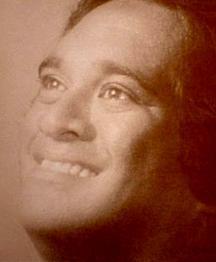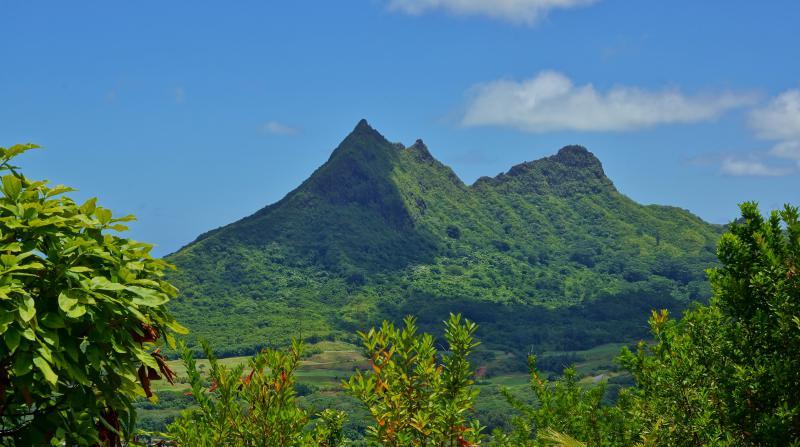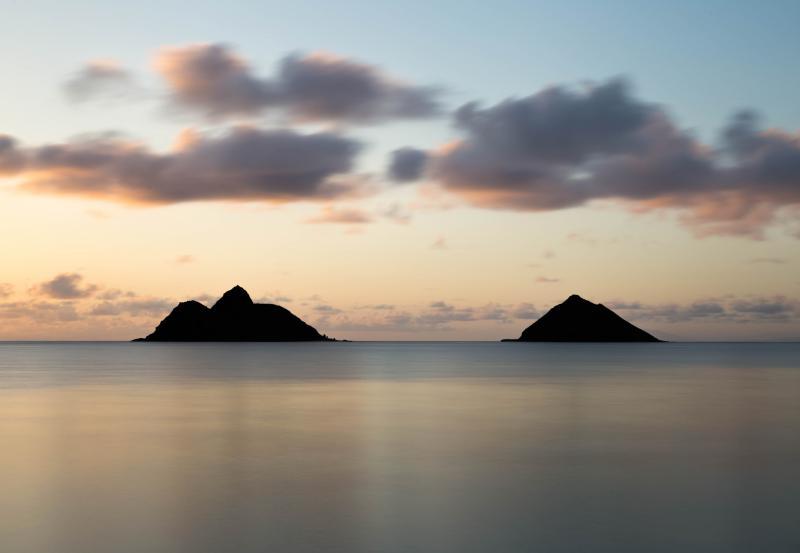Digital Collections
Celebrating the breadth and depth of Hawaiian knowledge. Amplifying Pacific voices of resiliency and hope. Recording the wisdom of past and present to help shape our future.
Kīhei de Silva
This mele is twenty-two years old, but its author recently added four new verses to the original four-verse composition—"an accomplishment," he says, "that finally brings the song to its proper conclusion. It was only half a lei; now it’s whole." De Silva’s complete explanation of the song —or "as complete as it gets"—is included below.
Hanohano Wailea i ka‘u ‘ike lā
Ka wahine kia‘i ‘au i ke kai
Pūnāwai ‘ili‘ili nehe i ke kai lā
‘Auana ka wai ‘olu i ka ulu hala
Halakau ‘o Ka‘iwa i luna lilo lā
Ne‘e mai ‘o Ahiki i ke kualono
Kualena ‘o Alāla i ke ao ‘ōpuku lā
Kolo mai ka ‘iewe a‘o Kūali‘i
Kua‘au kai ‘ōlena ka‘u i aloha lā
Kau aku ka hali‘a i nā Mokulua
Pilikua pilialo i ke awe ‘ula lā
E nānā mai ka maka, ‘ike pū ka pono
Ho‘olono Ka‘ōhao i kēia mele lā
O ku‘u ‘āina nani e waiho nei
Ha‘ina ‘ia mai ana ka puana lā
Hanohano Wailea i ka‘u ‘ike.
I hold Wailea in high regard; she is glorious in my sight
She is the guardian-woman who reaches into the sea
The pebbles of Pūnāwai clatter in the tide
Its cool waters wander through the hala grove.
Ka‘iwa rests high above
Ahiki moves closer to her, to her mountain ridge
Alāla stretches taut the skin of ‘ōpuku clouds
The descendants of Kūali‘i draw near
The sheltered sea of Kai‘ōlena is what I love
Fond memories come to rest at Mokulua
They are husband and wife in the red rays of sunrise
May the eyes observe and understand
Ka‘ōhao attends to this mele
Of my beautiful land spread out below
Tell the song’s refrain
Glorious is Wailea in my sight.
I composed "Hanohano Wailea" in 1984 after a walk to the beach. I went there to cool off after a day of yard work, but I came home quickly, far from cooled-off, with a mele brewing in my head. I’ve said elsewhere that I was inspired by the beauty of what I saw, but I was, in fact, aggravated by the pālaualelo of what I’d heard. I wrote "Hanohano Wailea" in response to a self-styled keiki o ka ‘āina who had been giving his house guests a quick lesson in Lanikai landmarks. "That over there," he said, "is Smith’s Point. Behind us is Pillbox Hill and to the north is Mid-Pac Knoll. And those twin islands out there are the Mokes." [1]
Usually it takes me a long time to write a mele. I can spend a whole day worrying over a single phrase. But "Hanohano Wailea" took less than an hour. My mind was already full of Sites of O‘ahu research and Jiro Tanabe stories, so I had pretty much figured out what to write before I even got back to the house. [2]
My purpose was simple: name the old names of Ka‘ōhao. Put them back in our mouths and ears where they belonged. Ka‘ōhao itself was a lost name, long out of everyday use. It had been swallowed up since 1925 by "Lanikai," a name that—like Smith’s, Pillbox, Mid-Pac, and Mokes—was no name at all. "I’ll never leave / Can’t say goodbye / I love you so / My Lanikai" is what the neighborhood kids, my oldest daughter included, had been singing for years at Lanikai Elementary. Thanks to Mr. Palaualelo, I’d finally had my fill of this kai pāpa‘u, this shallow-sea ignorance; it was time to respond.
I patterned my song after the travelogue mele of the late 19th century: place name plus description, place name plus description, place name plus description, all on a metaphorical path to affirmation and enlightenment. My roll call of names included Wailea, Pūnāwai, and Ka‘iwa, and I moved along the Ka‘ōhao ridgeline in an easy east-to-west sequence that was meant to encompass the land below in understanding’s warm embrace. I wanted a short song, one that that would improve the ‘ike not overwhelm it. One that could easily be sung and remembered by the children for whom it was intended, my own daughters most of all. So I didn’t use all the land names that I knew, and I left the ocean names completely out of the four-verse mele. I thought I’d wait a bit, work some of those names in later, and eventually wrap the whole thing up with a tidy ha‘ina.
It has taken me two decades to get back to "Hanohano Wailea." To balance it off and finish it up. In the meantime, the song has taken on a life of its own. It began as a mele hula kālā‘au, but my friend Wilfred Keale got hold of the words and made Moe-magic out of it. Kawai Cockett later poured all of his heart into it, as did Johnny Lum Ho in turn. Today it is sung beautifully by Keawe Lopez, ‘Ale‘a, Holunape, Moana Chang, and Nā Palapalai. It is sung, as well, by the children of what is now Lanikai Charter School; it is their school song. They go to Lanikai, but they will tell you right away, "the real name is Ka‘ōhao."
The song’s four new verses, composed twenty-one years after the original, are not aggravation-inspired, nor are they meant as poetic counter-revolution. [3] Their purpose is to complete, bind, and adorn. One meaning of Ka‘ōhao is "the tying-end, as of a lei." "Hanohano Wailea," in its original four-verse form is a half-circle, a cupped hand, a one-armed hug, an incomplete lei. The new verses for Alāla, Nā Mokulua, and Kai‘ōlena supply the missing half and tie the whole together in a lei aloha ‘āina with which I honor my Ka‘ōhao family.
My wife Māpuana has lived in Ka‘ōhao for fifty-five years. Her mother descends from the chief Kūali‘i whose piko-cutting ceremony was conducted at Alāla Heiau. Both of Māpu’s parents, like Nā Mokulua, are now at rest, at watch, in the sea of Kai‘ōlena. Māpu and I have lived here together since 1973. And our daughters, Kahikina and Kapalai, now and 29 and 22, have lived here all their lives.
Ultimately, the new version of the song is meant for the two girls, now women, who grew up with "Hanohano Wailea" and whose lives were shaped by its determination to name and remember. It returns to them now as a celebration of the people and places that watch over them and define them as ēwe hānau hou o ka ‘āina. Real natives, not the self-appointed pālaualelo variety. May there be determined, resilient generations to follow. May this song live to dignify them, to give them their ho‘ohanohono due. ‘Ewalu paukū, ‘elua nō pua, lawa ku‘u lei.
1. The correct names are Wailea, Ka‘iwa, Alāla, and Nā Mokulua. "Smith’s Point" (Wailea) gets its inoa haole from Alvin Smith, who build an estate there in the 1930s (Jiro Tanabe, personal communication, 1983); the other misnomers are self-explanatory.
2. Jiro Tanabe grew up in Ka‘ōhao when it was still ranch land and watermelon farm. He is in his late 80s and still lives down the street from us.
3. Well, maybe a little bit. The fortified estates of Mokulua Drive and the absentee land-barons who own them are the antithesis of aloha ‘āina and therefore a target of "Hanohano Wailea" in both old and new forms.
Notes to the Mele:
Wailea is the point that divides Ka‘ōhao from Waimānalo. It was a place for fish-spotting, and offerings to a stone god of the same name were once made here (Sterling and Summers, Sites of O‘ahu, 239). Pukui tells us that Wailea means "water of Lea" (Place Names, 224) and that it refers to the goddess of canoe-makers (Hawaiian Dictionary, 239). Lea is known in other traditions as Hinaulu‘ōhi‘a, a guardian goddess of po‘e hula (Beckwith, Hawaiian Mythology, 563).
Pūnāwai is now a cement drainage ditch that runs from cliff to beach at the far end of Ka‘ōhao. In older days it was a meandering stream noted for the hala groves on its banks and the ‘ili‘ili at its mouth. Women were quartered here near the beach while their men trained at spear-throwing on the Ka‘ōhao plain (Sites of O‘ahu, 239). Pūnāwai also is the name of our home in Ka‘ōhao; we have a seven-tree hala grove in our yard, and our students—we like to say—are the ‘ili‘ili that still dance in the tide.
Ka‘iwa is the ridge that divides Ka‘ōhao from Ka‘elepulu (commonly called "Enchanted Lakes"). Sterling and Summers report that the ridge was named for a chiefess who made her home here (Sites of O‘ahu, 239).
Ahiki is the Waimānalo-most peak of the Olomanas. In ancient times, Ahiki was also the konohiki of the Kawainui and Ka‘elepulu fishponds. A legend recorded by Sterling and Summers explains Ahiki’s geographic separation from the other Olomana peaks: he was so taken with the chiefess Ka‘iwa that he rose up and pulled himself away from his brother peaks in order to be closer to her (Sites of O‘ahu, 239). The story of Ka‘iwa and Ahiki makes for a bit of de Silva kaona. I lived with my family in Maunawili (the land of Ahiki) until I married Māpu and moved to Ka‘ōhao. Like Ahiki, I was drawn here by love for Ka‘iwa.
Alāla ("Awakening") is the ridge and point that divides Ka‘ōhao from Kawailoa (the southern end of what is now Kailua Beach Park). The 17th century chief Kūali‘i was born at Kalapawai (now at the northern end of the same beach park); his piko-cutting ceremony was conducted at Alāla Heiau and accompanied by the drumming of two sacred pahu: ‘Ōpuku and Hāwea (Fornander, An Account of the Polynesian Race, II:278).
My wife Māpuana is a descendant of Kailewa, the name given to Kūali‘i in his later years (Sally Wood Naluai, personal communication, 1991). The proverb "Kolo ke ēwe i ka ‘iewe" is expressive of the bond felt by people who share a common ancestry: they creep and crawl to each other; they seek each other out (Pukui, ‘Ōlelo No‘eau, 322; Dictionary, 43, 94).
Kai‘ōlena is sea-water mixed with ‘ōlena and used for ceremonial purification. The name belongs to the section of beach and ocean ma kai of Lanikai Park and accessible from the Kai‘ōlena St. right-of-way. The name may refer, in part, to the ‘ōlena-colored sand and water of our reef-protected strand and to the healing properties that some of the old-timers attributed to the ocean here (Jiro Tanabe, personal communication, 1983). Kai‘ōlena has particularly strong family connections because it encompasses the points of departure, destination, and return for the canoes that scattered the ashes of Māpu’s parents.
Nā Mokulua are the "twin" islands at the outer edge of the ‘A‘alapapa reef. The two are further identified as Mokunui and Mokuiki, but their older names are no longer remembered (Tanabe, 1983).
Pilikua (guarding-the-back) and Pilialo (clinging-to-the-front) are poetic expressions for husband and wife (Pukui, ‘Ōlelo No‘eau, 893, The Polynesian Family System in Ka‘ū, 163). The Kua/Keawe references hint at the interweaving of my wife’s Kūali‘i line and my own Kua (of Ka‘ū) and Keawe‘īkekahiali‘iokamoku lines in our daughters Kahikina and Kapalai‘ula—the mamo for whom these new verses have been composed.
Ka‘ōhao means "the tying" and takes its name from the tying of two women by Hāuna, kahu to high chief Lonoikamakahiki of Hawai‘i Island, after the women were beaten at a game of kōnane. The women were led to Hāuna’s canoes, released, and—against all expectation—rewarded with the feather wealth that the wa‘a contained. That place was named Ka‘ōhao in commemoration of the incident. (The complete story is told in Fornander’s Collection, IV:314–315.) "Lanikai" is the 1920s concoction of Charles Frazier, the district’s developer who was under the mistaken impression that he was naming the place ‘heavenly sea’ (Honolulu Advertiser, 8-15-1948). His word order, however, was hemahema; "in Hawaiian the modifier commonly follows the noun; hence Lanikai means ‘sea heaven, marine heaven’" (Pukui, Place Names of Hawai‘i, 129).
In 1926, Frazier and the Trent Trust Co. subdivided the 100-plus acres that he had bought from Maunawili Ranch, put up the lighthouse-shaped monument at Alāla Point, and announced the sale of thirty-two vacation home lots. Ka‘ōhao was actually the name of the northernmost of two land divisions bordered by Alāla and Wailea points; the second of these is identified on the old maps as Mokulua. Frazier and Trent bought Mokulua shortly after their initial purchase of Ka‘ōhao, and both old names were swallowed up by the misnomer Lanikai. (John Clark, Beaches of O‘ahu, 175; Jiro Tanabe, personal communication, 1983.)
Ha‘ina. I’m calling this verse "newly composed," but Nā Palapalai actually came up with it in 2002 when they sang "Hanohano Wailea" for Leina‘ala Kalama Heine’s Hālau Nā Pualei at the King Kamehameha Competition. ‘Ala had asked permission to dance the "old" mele with the added ha‘ina, and I happily approved.
"Hanohano Wailea" Discography:
Moe Keale, Aloha Is . . . A Part Of Me, A Part Of You, MDL6408.
Kawai Cockett, ‘O Ka‘ōhao Ku‘u ‘Āina Nani, Ho‘olokahi Productions, HPC-203.
Anuhea, Kahiau ‘ia ke Aloha, Mana Pa‘i Records, AK47-1CD.
Hawaiian Time, Island Dream, Lāna‘i Boyz 0002.
Ray Sowders, Ho‘omālie, RS 2000.

photo courtesy of: South Sea Island Magic
"Hanohano Wailea" began as a mele hula kālā‘au, but Wilfred Keale got hold of the words and made Moe-magic out of it. Moe’s "Aloha is ..." recording of the song still confuses people: "What happened to the tune; how come he sings it so differently from the way it’s done today?" The fact is, Moe came up with two tunes for the mele: the "hula" version that everyone sings now, and what he called the "Hi‘ilawe" version for his LP. What happened was this: Moe recorded the song just before "his" hālau was going to present it for the first time at Merrie Monarch. He didn’t want the hula tune to be heard until that night, so he recorded it the other way—as a disguise. "We go fool ‘em," he said. And he did.

photo credit: Eric Tessmer, Wikimedia Commons
Ahiki, the roundest of Olomana’s three peaks, sits closest to Waimānalo.

photo credit: Christian Joudrey, Wikimedia Commons
Nā Mokulua, the "twin" islands at the outer edge of ʻAʻalapapa reef.